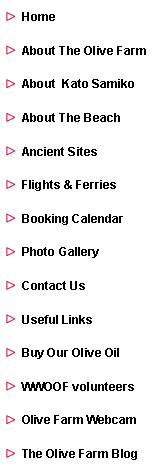|
Organic Farming at The Olive farm
|
|
We took the decision to run our farm using organic methods several years ago, and we are registered as Organic Farmers. We are currently working through the transition period to obtain full Organic status for our olive oil. This is a slow process, but we believe it will be worthwhile not only in terms of the quality of oil that we produce, but also for the land itself and its natural flora and fauna.
Our aim is to manage our land as efficiently as possible, but using natural processes wherever possible. For example, amongst our neighbours it is common practice to burn all the branches removed from the olive trees during pruning (several tons each year), which effectively removes them from the organic cycle of the land. However, we turn them into chippings which are in turn composted, and the compost is used as a replacement for the chemical fertilizers that non-organic farming would use.
The coming year will hopefully see the addition of livestock to enhance the quality of our compost, and also cut down the amount of grass-cutting that is required. Incidentally, we will also gain in dairy produce and meat for the table. |





|
Early in the year we apply organic fertilizer and compost to the trees, as there is (hopefully) an abundance of rain to help settle in the nutrients.
Spring sees us pruning the trees, to make sure that the new growth will develop cleanly and not provide a haven for parasites and diseases.
The summer months are a nail-biting wait, as the olives develop. There is little we can do but wait and watch to see if the weather will be kind to us and our trees. Keeping the land clear to avoid any risk of fire is our main priority.
Autumn brings with it rain to ripen the fruit, if we are lucky, and with the rain comes an explosion of small flies that like to eat our olives. We use traps to try to cull their numbers without affecting the olives (the non-organic method is to use insecticides indiscriminately through-out the summer and autumn).
From November onwards the harvest begins in earnest. The trees are pruned as we go, removing those branches filled with olives to stimulate new growth which will in turn fruit the year after next. The olives are gathered into sacks and taken immediately to our local press, where the traditional method of donkey-powered grinding stones has been replaced by something rather more efficient, as required by EU regulation. |



